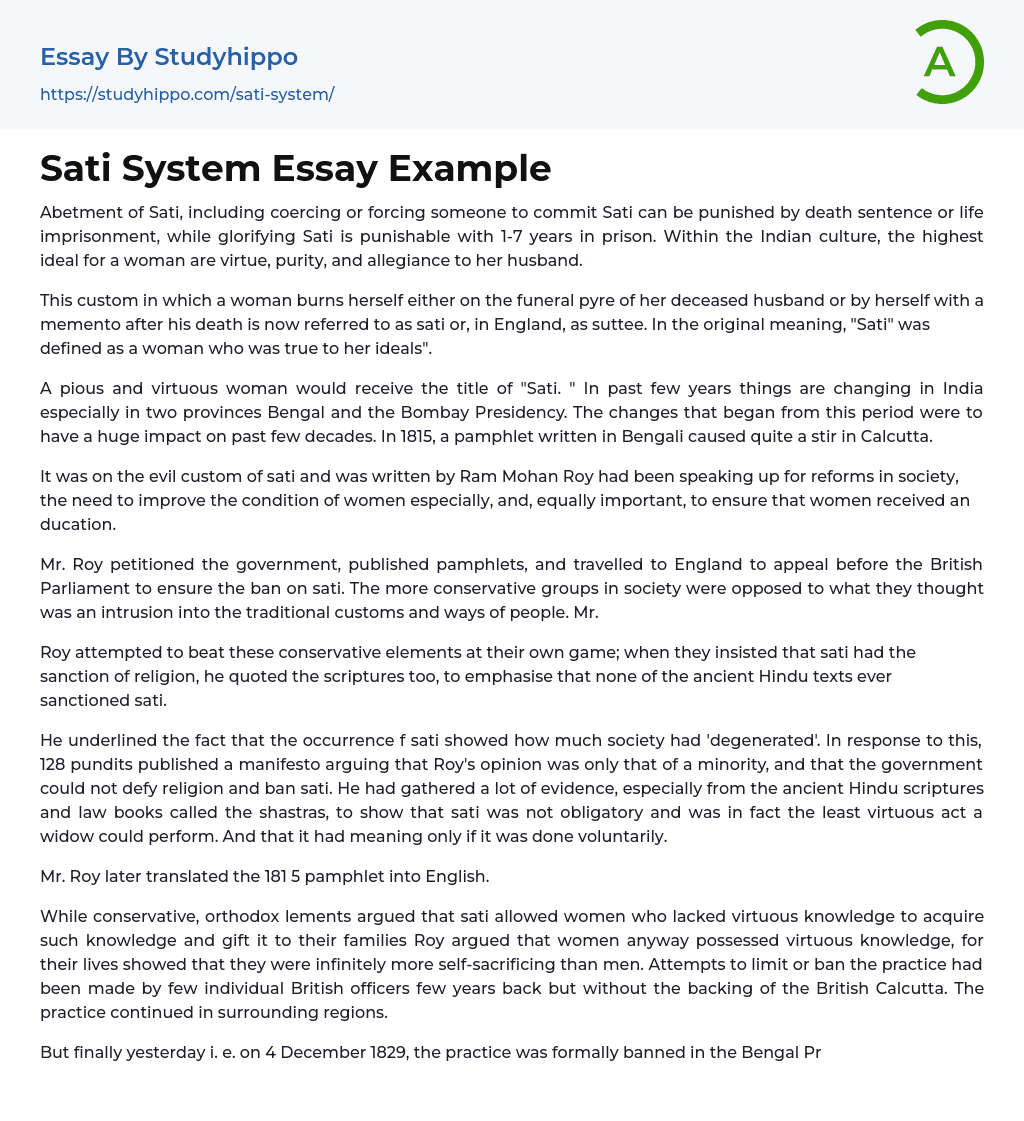Abetment of Sati, including coercing or forcing someone to commit Sati can be punished by death sentence or life imprisonment, while glorifying Sati is punishable with 1-7 years in prison. Within the Indian culture, the highest ideal for a woman are virtue, purity, and allegiance to her husband.
This custom in which a woman burns herself either on the funeral pyre of her deceased husband or by herself with a memento after his death is now referred to as sati or, in England, as suttee. In the original meaning, "Sati" was defined as a woman who was true to her ideals".
A pious and virtuous woman would receive the title of "Sati. " In past few years things are changing in India especially in two provinces Bengal and the Bombay Presidency. The changes that began from this
...period were to have a huge impact on past few decades. In 1815, a pamphlet written in Bengali caused quite a stir in Calcutta.
It was on the evil custom of sati and was written by Ram Mohan Roy had been speaking up for reforms in society, the need to improve the condition of women especially, and, equally important, to ensure that women received an ducation.
Mr. Roy petitioned the government, published pamphlets, and travelled to England to appeal before the British Parliament to ensure the ban on sati. The more conservative groups in society were opposed to what they thought was an intrusion into the traditional customs and ways of people. Mr.
Roy attempted to beat these conservative elements at their own game; when they insisted that sati had the sanction of religion, he quoted the
scriptures too, to emphasise that none of the ancient Hindu texts ever sanctioned sati.
He underlined the fact that the occurrence f sati showed how much society had 'degenerated'. In response to this, 128 pundits published a manifesto arguing that Roy's opinion was only that of a minority, and that the government could not defy religion and ban sati. He had gathered a lot of evidence, especially from the ancient Hindu scriptures and law books called the shastras, to show that sati was not obligatory and was in fact the least virtuous act a widow could perform. And that it had meaning only if it was done voluntarily.
Mr. Roy later translated the 181 5 pamphlet into English.
While conservative, orthodox lements argued that sati allowed women who lacked virtuous knowledge to acquire such knowledge and gift it to their families Roy argued that women anyway possessed virtuous knowledge, for their lives showed that they were infinitely more self-sacrificing than men. Attempts to limit or ban the practice had been made by few individual British officers few years back but without the backing of the British Calcutta. The practice continued in surrounding regions.
But finally yesterday i. e. on 4 December 1829, the practice was formally banned in the Bengal Presidency lands, by the governor, Lord William Bentinck.
- Mahayana essays
- Afterlife essays
- Atheism essays
- Bible essays
- Buddhism essays
- Christian Worldview essays
- Christianity essays
- Confession essays
- Cosmological Argument essays
- Deism essays
- Devil essays
- Existence of God essays
- Faith essays
- Freedom Of Religion essays
- God essays
- Hinduism essays
- Immortality essays
- Islam essays
- Jainism essays
- Jews essays
- Judaism essays
- Miracle essays
- Monk essays
- Monotheism essays
- New Testament essays
- Old Testament essays
- Pilgrimage essays
- Puritans essays
- Revelation essays
- Ritual essays
- Salvation essays
- Sin essays
- Sinners essays
- Soul essays
- Taoism essays
- Temple essays
- Theology essays
- Bangladesh essays
- China essays
- Hong Kong essays
- India essays
- Japan essays
- Kuala Lumpur essays
- Malaysia essays
- Manila essays
- Pakistan essays
- Philippines essays
- Singapore essays
- Vietnam essays
- Vietnamese essays




